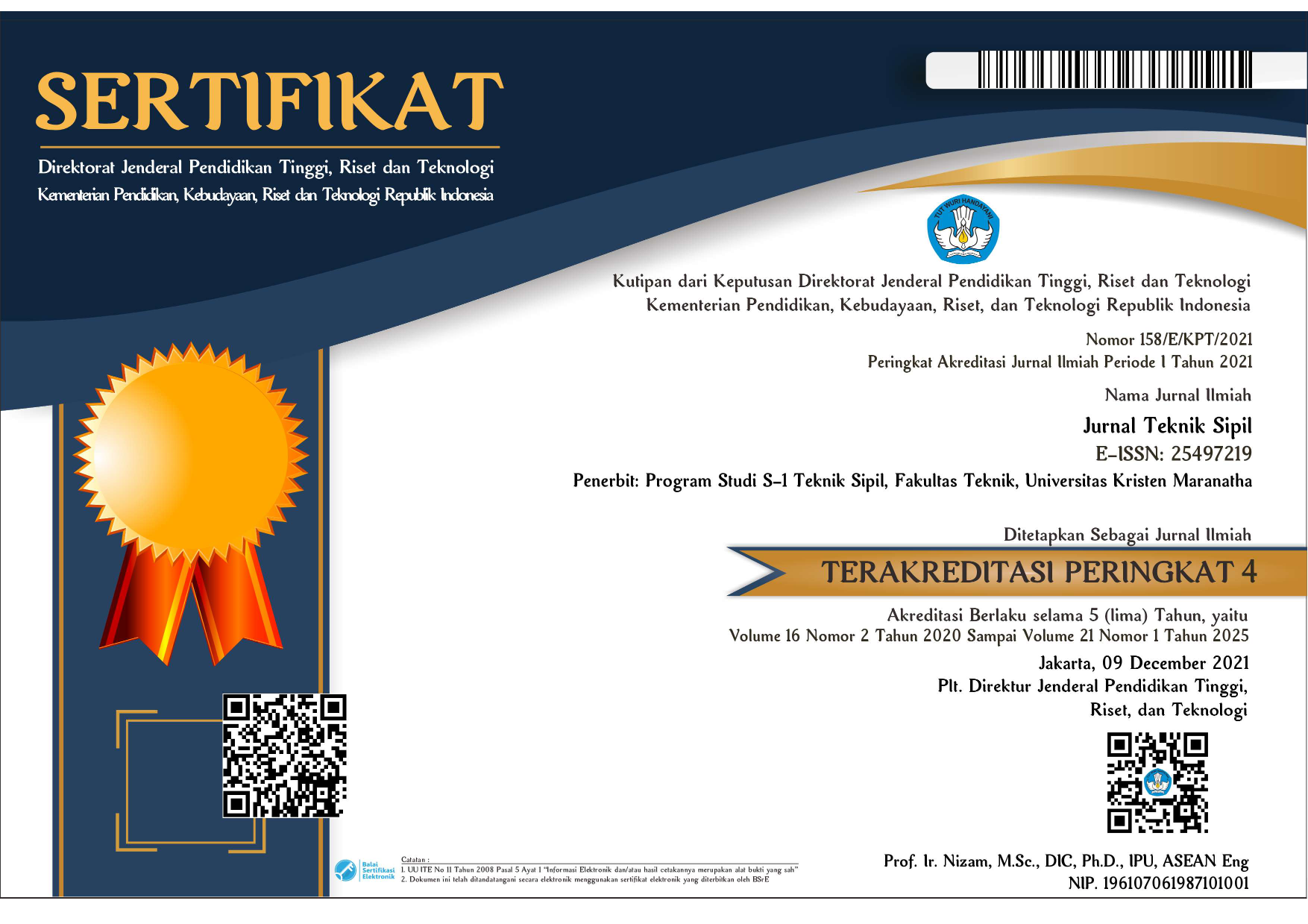ANALYZING THE EFFECT OF WATER SEEPAGE AND SCOUR ON SLOPE STABILITY USING FINITE ELEMENT METHOD
DOI:
https://doi.org/10.28932/jts.v18i2.4272Keywords:
Groundwater Table, Finite element Method (FEM), Landslides, Parametric Studies, Multilaminate Model, Creep/ViscoplasticAbstract
On every slope, there is always the possibility of landslides. One of the hypotheses tested was the effect of water flow and scour on slope stability at the investigated location. A brief inspection was carried out to determine the condition and influence of the river, in addition to soil investigations, for proper follow-up arrangement. At landslide sites, water flow has an effect in raising the groundwater level so as to reduce the soil shear strength. Its causes the slope safety factor to drop below the safe rate. The scouring disrupts the stability of the slope but does not reduce the slope safety factor significantly. The parametric studies are chosen for their strong relation between measured displacement within the slope, to verify the measurements and the numerical analysis (Finite Element Method) results. The parametric study simulation shows that time-dependent numerical model could be useful as forecasting tool, including various possible scour and non-scour condition.Downloads
References
Aydan, O., Ito, J., Akagi, T., Ito, T., & Sato, J. 1995. Prediction of deformation behaviour of a tunnel in squeezing rock with time-dependent characteristic. Pages 463-469 of: Pande, G.N., & Pietruszczak, S. (eds), NUMOG V, Davos, Switzerland, 1995. Balkema. 5th Int. Symp. on Numerical Models in Geomechanics.
Bingham, E.C. 1922. Fluidity and Plasticity, 1 Ed. New York: McGraw-Hill.
Briaud, Jean-Louis. 2007. Case Histories in Soil and Rock Erosion: Woodrow Wilson Bridge, Brazos River Meander, Normandy Cliffs, and New Orleans Levees - The 9th Ralph B. Peck Lecture - Prof J.L. Briaud; Holder of the Buchanan Chair Texas A&M University
Chow, V. T., Maidment, D. R. & Mays, L. W., 1988. Applied Hydrology. New York: McGraw-Hill.
Das, B. M., 1985. Principles of Geothecnical Engineering. 3rd ed. Boston: PWS Publishing Company.
De Caro, M., Crosta, G. B., Castellanza, R., Agliardi, F., Volpi, G., & Alberti, S.; 2016, 2D modelling of rockslide displacements by non-linear time dependent relationships. In Landslides and engineered slopes. Experience, theory & practice. Proc. of the 12th int. sym. on landslides (Napoli, 12-19 Jun 2016).
Handayani, T., Wulandari, S. & Wulan, A., 2014. Pengaruh Muka Air Tanah terhadap Kestabilan Lereng menggunakan GeoSlope/W 7.12. Jakarta, s.n., pp. 409-415.
Kothari, C. R., 2004. Research Methodology: Methods and Techniques. 2nd ed. New Delhi: New Age International.
Lareno, B., Louhenapessy, W.G., 2019. Site Visit to the Project Site & Discussion at site, West Java.
Louhenapessy, W.G., 2003. Finite Element Method (FEM) in rock tunnel engineering: Introduction to a New Method of Tunnel Support Design, The Proc. of Konp.Geoteknik Indonesia VI, August 2003, HATTI.
Louhenapessy, Wilham G., 2000. Analysis of Tunnel Supports using the Finite Element Method. Ph.D. thesis. Department of Civil Engineering, University of Wales Swansea, Swansea, UK (now: Swansea University)
Louhenapessy, Wilham G. and Pande, G.N. 2000. Newmo3962_2000: User’s Instruction Manual, Internal Report No.CR / 1022/ 00. Dept. of Civil Eng, Univ. of Wales Swansea.
Marhendi, T., 2018. Pengaruh Meander dan Keamanan Lereng Terhadap Kejadian Longsor di Jalan Raya Prupuk-Bumiayu (km 115+50 – 115+900). Techno, April, 19(1), pp. 007-014.
Melville, B. W., 2015. Pressure-flow scour at bridges. In: D. &. A. Cheng, ed. Scour and Erosion. London: Taylor & Francis Group, pp. 449-453.
Pande, G.N. & Williams, J.R. 1990. Numerical Methods in Rock Mechanics. Chichester: John Wiley.
Pande, G.N. & Sharma, K.G., 1983, Multilaminate model of clays – a numerical evaluation of the influence of rotation of principal stress axes. International Journal for Numerical and Analytical Methods in Geomechanics, Vol. 7, No. 4, 397-418.
Pande, G.N. & S. Pietruszczak, 2015. On Unsaturated Soil Mechanics – Personal Views on Current Research, Studia Geotechnica et Mechanica, Vol. 37, No. 3, 2015 - DOI: 10.1515/sgem-2015-0035
Panet, M. 1996. Two case-histories of tunnels through squeezing rocks. Rock Mechanics & Rock Engineering, 29 (3), 155-164.
Panet, M., & Guenot, A. 1982. Analysis of convergence behind the face of a tunnel. Pages 197—204 of: Tunnelling 82. A.A. Balkema.
Rahardjo, Harianto; A. Satyanaga and E. C. Leong. 2016. Effects of Rainfall Characteristics on the Stability of Tropical Residual Soil Slope. E3S Web of Conferences 9, 15004.
SNI Geoteknik 8460:2017 - Persyaratan perancangan geoteknik. Badan Standardisasi Nasional.
Satyanaga, A.; M. Wijaya; Q. Zhai; Sung-Woo Moon; J. Pu and J.R., 2021. Stability and Consolidation of Sediment Tailings Incorporating Unsaturated Soil Mechanics, Fluids 2021, 6, 423. https://doi.org/10.3390/fluids6120423
G. Swoboda; W. Mertz; G. Beer. 1987. Rheological analysis of tunnel excavations by means of coupled finite element (FEM) – boundary element (BEM) analysis; International Journal for Numerical and Analytical Methods in Geomechanics Vol. 11; Issue #2.
Zienkiewicz, O.C., & Cormeau, I.C. 1974. Visco-plasticity - Plasticity and Creep in Elastic Solids - A Unified Numerical Solution Approach. Int. J. for Numerical Meth. in Engineering, 8, 821-845.
Zienkiewicz, O.C., & Pande, G.N. 1977. Time dependent multi-laminate model of rocks - a numerical study of deformation and failure of rock masses. Int. J. Numerical and Analytical Meth. in Geomech. 219-247
Downloads
Published
How to Cite
Issue
Section
License
Copyright (c) 2022 Wilham George Louhenapessy, Bambang Lareno

This work is licensed under a Creative Commons Attribution-NonCommercial 4.0 International License.


















